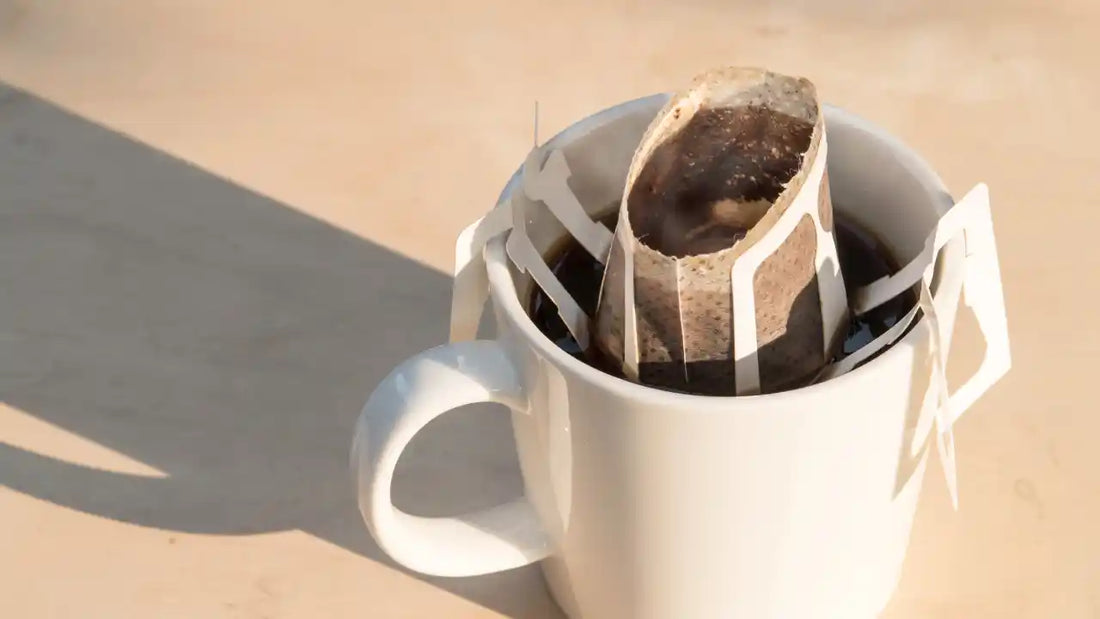
Drip Coffee to Water Ratio: The Foolproof Formula for a Perfect Brew
Share
What’s the Best Coffee-to-Water Ratio for Drip Coffee?
Let’s cut to the chase. If you’re looking for a foolproof ratio, most coffee professionals recommend a 1:15 to 1:18 coffee-to-water ratio for drip brewing. That means:
1 gram of coffee for every 15–18 grams (or ml) of water
Here’s what that looks like in real-world terms:
|
Coffee |
Water |
Brew Strength |
|---|---|---|
|
15g |
225ml |
Strong |
|
18g |
270ml |
Balanced |
|
20g |
300ml |
Light |
If you’re brewing a single cup (about 250ml), you’ll want around 16–17 grams of coffee for a nice balanced cup.
Quick hack if you don’t have a scale:
Use 1 heaped tablespoon of coffee for every 6 oz (180 ml) of water.
But honestly, if you really want consistency? Invest in a kitchen scale. It’ll level up your brew game faster than any new gear.
Why Coffee to Water Ratio Matters (Taste, Strength, Balance)
Think of your coffee-to-water ratio like a recipe. Too much of one thing? It’s off. Not enough of another? Still off.
Here’s what your ratio is actually controlling:
1. Taste & Strength
- A lower ratio (e.g. 1:15) = stronger brew with deeper, bolder notes. Great if you like a robust, punchy cup.
- A higher ratio (e.g. 1:18) = lighter brew with more subtle flavors. Ideal if you prefer a clean, easy-drinking cup.
Pro tip: Strength ≠ bitterness. You can have a strong yet smooth cup with the right ratio and grind.
2. Balance
The ratio helps balance:
- Acidity (too little coffee = sour or watery taste)
- Bitterness (too much coffee = over-extracted or harsh taste)
When the balance is right, you’ll taste:
- Sweetness in the cup
- Nuanced flavors (floral, fruity, nutty, etc.)
- A clean finish
3. Consistency
Using the same ratio every time means:
- You know what to expect.
- You can adjust variables like grind size or brew time without throwing everything off.
So, if your coffee’s been hit-or-miss lately, adjusting your ratio might be the quickest way to fix it, no new gear required.
Ratio Basics: Drip vs. Pour-Over vs. Other Brewing Methods
Every brew method has its personality, and that includes how much coffee and water it needs. Let’s break it down.
Drip Coffee / Pour Over
- Recommended ratio: 1:16 to 1:18
- Sweet spot: 1:17
This is your classic filter brew: clean, bright, and great for exploring coffee’s flavor nuances. Start with 1:17 (e.g., 17g water for every 1g coffee) and adjust from there depending on strength preference.
💡 Tip: Pour-over and drip are both percolation methods, meaning water flows through coffee grounds, so they tend to need slightly less coffee than immersion methods.
French Press
- Recommended ratio: 1:12 to 1:16
- Sweet spot: 1:15
French press is all about immersion, the coffee steeps in water, extracting more body and oils. That’s why it usually needs more coffee for a balanced cup. Try 1:15 to start, then tweak based on your roast and taste.
Espresso
-
Brew ratio: ~1:2
Espresso is a different beast. You’re forcing hot water through finely ground coffee under pressure, extracting intense flavors in seconds.
Here, the brew ratio refers to the amount of coffee vs. espresso liquid in the cup:
Example: 18g coffee → 36g espresso shot
Not to be confused with drip-style coffee-to-water ratios!
Quick Brew Ratio Comparison Chart
|
Method |
Ratio Range |
Strength |
Brew Style |
|---|---|---|---|
|
Drip / Pour Over |
1:16–1:18 |
Balanced |
Percolation |
|
French Press |
1:12–1:16 |
Rich & full |
Immersion |
|
Espresso |
~1:2 |
Strong & bold |
Pressure |
How to Scale Your Brew: From Cups to Grams
Want to brew more than one cup without messing up the strength? This is where ratios shine and where a kitchen scale becomes your best friend.
Start with the Golden Ratio
Most drip coffee fans swear by a 1:17 coffee-to-water ratio. That means:
1 gram of coffee for every 17 grams (or ml) of water.
So if you’re brewing 800 ml of water (about 4 cups): Divide 800 by 17 = ~47 grams of coffee.
💡 Tip: Always measure your water and coffee before brewing, not after. The scale helps you control strength and taste better than any scoop ever could.
No Scale? Here’s a Rough Guide
We get it. You’re on the go, or your digital scale’s out of battery. Use this ballpark measurement: ~2 tablespoons (~10 g) of coffee per 6 oz (180 ml) of water
|
Cups |
Water (ml) |
Coffee (g) |
Tablespoons |
|---|---|---|---|
|
1 |
180 ml |
10 g |
~2 tbsp |
|
2 |
360 ml |
21 g |
~4 tbsp |
|
4 |
720 ml |
42 g |
~8 tbsp |
This isn’t perfect, but it’s decent for casual brewing.
Coffee Ponding & Why Accuracy Matters
Ever notice some brews look “muddy,” or extract unevenly? That’s coffee ponding, when water pools unevenly over the grounds, usually due to incorrect coffee dose or uneven grind.
Using a scale helps:
- Avoid under- or over-dosing
- Maintain consistency brew after brew
- Dial in flavor more precisely (especially when testing new beans)
Whether you’re brewing one cup or a whole pot for friends, the math doesn’t have to be scary. Stick to the ratio, and let your kitchen scale do the heavy lifting. Your taste buds will thank you.
The Coffee Strength Spectrum: How Ratios Impact Flavor
Think of coffee ratios as the dimmer switch to your brew’s personality. A small shift can move your cup from mellow and tea-like to bold and punchy.
1:15 Ratio – The Bold & Heavy Cup
More coffee, less water = stronger brew.
Expect:
- Thicker mouthfeel
- Intense flavor
- Great for espresso-style brews or those who like their coffee to hit hard.
1:16–1:17 – The Golden Middle (a.k.a. the “Specialty Coffee Sweet Spot”)
This is where balance lives.
Expect:
- Rounded body
- Clear flavor clarity
- Ideal for pour-overs, AeroPress, French press, and most filter brews.
1:18 – The Light & Bright Cup
More water, less coffee = lighter brew.
Expect:
- Tea-like body
- Brighter acidity
- More nuanced notes, but may feel “watery” to some.
Why This Matters
Changing your ratio lets you dial in the cup to your mood or bean type.
Got a dark roast? Go a bit lighter on coffee.
Trying a fruity light roast? Keep it tighter to highlight the brightness.
✅ Experiment tip: Brew the same coffee at 1:15, 1:16.5, and 1:18. Taste side by side and see what you like best. There’s no right answer—only your favourite cup.
Step-by-Step Guide to Perfect Drip Brew Ratio
Want to master your daily drip brew? Here’s a foolproof path to consistent, delicious cups:
- Weigh your coffee beans – Start with 15g for every 250ml water (1:16.5 ratio).
- Measure water precisely – Use a scale or measuring cup.
- Grind fresh & uniform – Use a burr grinder for even extraction.
- Brew with water at 92–96°C – Not boiling, but hot enough to extract flavor fully.
- Use the right grind size – For drip, go with a medium grind (like table salt).
- Taste & tweak – If it’s too strong, increase water. Too weak? Add more coffee next time.
Want to deep dive into drip? Read our full post: Drip Coffee: A Timeless Brewing Method.
Common Mistakes with Coffee Ratios (And How to Avoid Them)
Even seasoned brewers mess this up sometimes. Watch out for these common slip-ups:
🔸 Eyeballing instead of measuring
Your “one heaping spoon” is not as consistent as you think. Use a scale for repeatable results.
🔸 Wrong grind for your brewer
Using espresso grind in a drip machine? That’ll over-extract and turn bitter. Match grind to method.
🔸 Not adjusting for batch size
Brewing for one? Or for four? Don’t forget to scale your coffee and water accordingly, that’s where ratio math matters.
🔸 Ignoring the taste test
The perfect ratio on paper might not be perfect for your palate. Always taste and tweak.
🔸 Assuming stronger = better
A super-strong brew (like 1:10) isn’t always pleasant, it can be harsh, overpowering, or muddy. Balance is key.
💡 Remember: Great coffee isn’t just science, it’s a dialogue between your taste buds and your brew method.
Wrap-Up: Brew Ratios = Brew Mastery
Think of brew ratios as your coffee’s compass. Whether you’re chasing bold and punchy or light and tea-like, the coffee-to-water ratio sets the tone. You don’t need fancy gear or barista-level training, just a scale, a spoon, and a little intention.
Start simple, taste often, and don’t be afraid to tweak. Because the best cup? That’s the one brewed exactly how you love it.
FAQs - Frequently Asked Questions
Q1. What is the best coffee-to-water ratio for drip brewing?
The most recommended coffee-to-water ratio for drip coffee is 1:15 to 1:17, that means 1 gram of coffee for every 15–17 grams (or ml) of water. This range gives you a balanced, flavorful brew. Adjust slightly based on how strong you like your coffee.
Q2. How do I measure coffee without a scale?
If you don’t have a scale, use a rough guideline: 2 tablespoons (about 10–12g) of ground coffee per 180ml (6 oz) of water. It’s not as precise, but it works in a pinch. Upgrading to a kitchen scale is the best way to improve your brews consistently.
Q3. Does changing the coffee ratio affect flavor?
Absolutely. A stronger ratio like 1:13 will give you a richer, more intense brew, great for bold flavor lovers. A lighter ratio like 1:18 will taste more delicate, tea-like, and aromatic. Coffee ratio is one of the fastest ways to tweak flavor without changing beans.
Q4. Is stronger coffee always better?
Not necessarily. While some people love a strong cup, overdoing the ratio can lead to bitterness or muddy flavors. The key is balance, a well-extracted medium strength brew often brings out the best in specialty coffee.
Q5. What’s the easiest way to improve my drip coffee?
Start by measuring your coffee and water, using the right grind size (medium), and brewing with water around 92–96°C. Once you lock in a ratio that works for you, small adjustments will take your coffee from “just okay” to café-quality.




